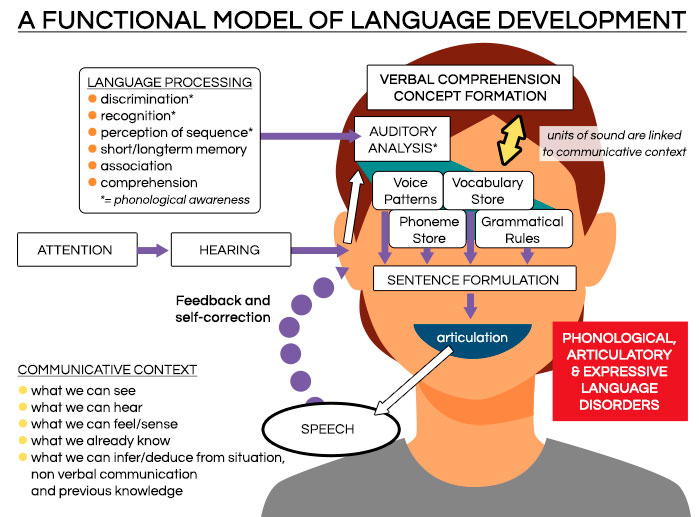Childhood Communication Consultancy (CCC) specialises in assessing and treating children ages 0-19 years old with speech, language, listening, literacy, learning and social communication difficulties. The aim of the assessment is to discover where the breakdown is occurring and to treat this. It will be helpful to review the processes that occur for effective communication, which have been covered in recent articles. Below is a model that shows how these processes work together:

1. Attention: A child needs to attend to the verbal message and the visual and sensory contextual information.
2, Hearing: A child needs to physically hear the verbal message that is not impeded by glue ear (excessive fluid in the middle ear) or any kind of hearing loss.
3. Listening/Auditory processing: The verbal message is sent up auditory pathways from the inner ear to the brain to make sense of the information.
4. Language processing: The verbal message is broken into ‘chunks’ so that it can be understood or comprehended(at the level of the sentence, phrase, word, syllable and sound boundaries) within the context. This can then be stored in the short and long term memory. This builds up stores of vocabulary and concepts i.e. hot/cold; heavy/light.
5. Sentence formulation: To express oneself, formulation takes place of the intent of the message, and of the words/phrases to convey that intent.
6. Articulation: To formulate the sentence, the articulatory sequence is planned and produced (speaking). Once spoken, the child will then hear what he/she has just said and be able to self-correct.
7. Social communicative context: Listening and speaking takes place in a social communicative context of what the child can: hear, see, feel/sense, already knows, infer/deduce from the situation and understand from non-verbal cues i.e. body language and the way the message is spoken.
8. Sensory processing: This is what occurs in the whole body of the child i.e. all the senses as well as balance and co-ordination. Auditory and visual processing are key aspects. The child’s sensory processing ability affects the whole communicative process.
9. Reading, writing, spelling (dyslexia): Aspects of language processing i.e. phonological awareness: discrimination, recognition, perception of sequence of sounds (phonemes) is necessary for the processing of text/letters (graphemes) and also requires visual processing. Reading also requires comprehension skills.
In the next article, Processes for Communication 2, breakdown of these processes will be discussed.
If you have any concerns about your child, please contact Jacqui to discuss this further.
